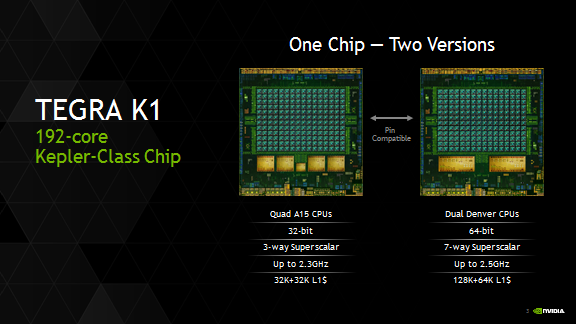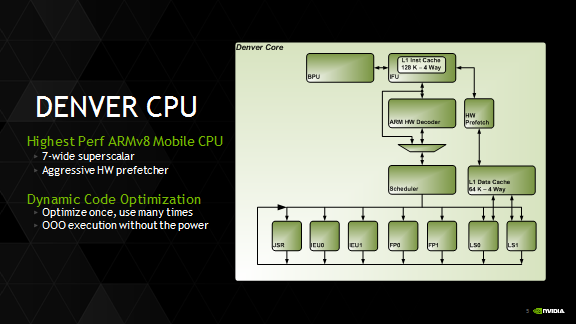Nvidia has officially introduced the 64-bit variant of the Tegra K1 SoC. Unlike all previous Tegra designs, the TK1 64-bit is based on a custom CPU core.
Nvidia’s Denver 64-bit core has been long in the making and at last we’re about to see what it can do in real world tests.

The Tegra K1 implementation features two ARMv8 CPU cores, but it is pin compatible with the 32-bit version of the chip. Nvidia says this should ease implementation and speed up time-to-market.
First 64-bit ARM processor for Android?
Nvidia describes the 64-bit Tegra K1 as the “world’s first 64-bit ARM processor for Android” which is a bit of a stretch. Another stretch is the console graphics claim, but truth be told Nvidia's 192 Kepler cores should be on par with console GPUs of years goneby.
“Denver is designed for the highest single-core CPU throughput, and also delivers industry-leading dual-core performance. Each of the two Denver cores implements a 7-way superscalar microarchitecture (up to 7 concurrent micro-ops can be executed per clock), and includes a 128KB 4-way L1 instruction cache, a 64KB 4-way L1 data cache, and a 2MB 16-way L2 cache, which services both cores,” Nvidia said.

The chip features 128MB of main memory optimization cache. It reduces the need to re-optimise software routines. Dynamic Code Optimisation optimizes frequently used software routines into dense microcode routines.
“Denver looks across a window of hundreds of instructions and unrolls loops, renames registers, removes unused instructions, and reorders the code in various ways for optimal speed. This effectively doubles the performance of the base-level hardware through the conversion of ARM code to highly optimized microcode routines and increases the execution energy efficiency,” the company said in a blog post.
Nvidia working to implement Android L on Tegra K1
Nvidia promises “amazing” devices based on the new part later this year. It also stressed that it is developing Android L on the 64-bit Tegra K1.
It is still too early to say what Android L and 64-bit support have to offer in terms of sheer performance gains, but the first ARM 64-bit parts are slowly starting to trickle out. This should compel developers to start looking at ARMv8 hardware seriously.
Nvidia says dual-core processors can attain significantly higher performance than existing four- to eight-core mobile SoCs on most workload. Since it was optimized for single –core performance, Denver should capitalize on this fact. On a side note, Nvidia was the first ARM outfit to offer a dual-core Cortex A9 part and it later introduced the first 4+1 core SoC. Now it is going back to dual-core designs, at a time when many competitors are embracing bit.LITTLE designs with six or more small cores.
The first device based on the Tegra K1 will in all likelihood be HTC Volantis tablet, which is Google’s next Nexus tablet. We don't have any information on upcoming Denver-based products other than the HTC/Google tablet at this point. One thing is certain though. Nvidia is not going after smartphone design wins with its first implementation of Denver.




